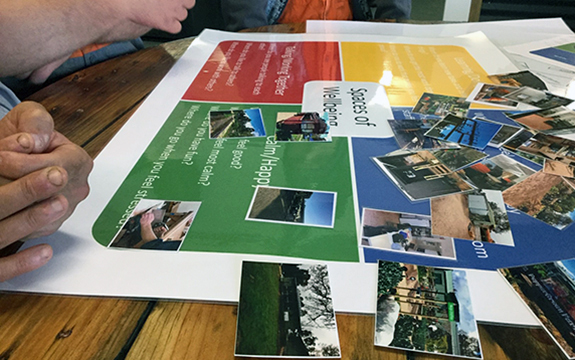Mapping wellbeing in the workplace

In Summary
- Swinburne and Access Australia are mapping wellbeing at two regional social enterprises that offer support for people experiencing social marginalisation
- Mapping work may help identify what features contribute to better social outcomes and improve the economic and social benefits of the enterprise
The water cooler has long been the place to congregate and chat at work, but workplaces offer a rich variety of other spaces where people gather, hide, learn, and feel safe or unsafe. These components are all part of wellbeing at work.
The micro-geographies of a building or outdoor workplace can create tiny territories of welcoming interaction or supportive places to gain new skills. Some spaces are less inviting or more stressful to occupy.
New fields of study are opening up into mapping and analysing what kind of resources are built for people in these work micro-geographies – and how that affects people’s behaviour, productivity and mental wellbeing at work, both positively and negatively.
Swinburne has partnered with Access Australia to map wellbeing at two Bendigo-based social enterprises – Access Creative Studios and Peppergreen Farm, which both offer skills training and employment programs for people experiencing various forms of social marginalisation.
Leading the project is Professor Jane Farmer, Director of the Social Innovation Research Institute at Swinburne.
“Our methodology uses visualisation to show wellbeing data. It’s a novel approach and so much more engaging than a dry report of facts and figures. It also allows everyone in a social enterprise to see and understand the data,” says Professor Farmer.
“We recently presented a report to the people at Peppergreen Farm. The visual and interactive aspects were very empowering for the supported employees, who can have low or no literacy. In the feedback, employees were totally equal players with the staff and the management.”
The impact of spaces on wellbeing might relate to work or workplace design, work practices, workplace discourses, in fact a mix. The mapping allows managers to see what is and isn’t working.
“Rather than trying to make every space wonderful, you try to understand what's happening in the positive spaces so you can target negative spaces more effectively and efficiently,” says researcher, Peter Kamstra, who is bringing his geography expertise to the project.
With new ways of capturing more detailed data, researchers are also able to ask deeper questions. “We can ask questions about people’s favourite place and why they like it,” says Mr Kamstra. “Asking why people feel the way they do gives us insights into features aligned with wellbeing and contextualises the space for people so they can tell a much richer story.”
Access Australia CEO, Dr Michael Langdon hopes that the mapping work will help to identify what features of a social enterprise might contribute to better social outcomes and improve the economic and social benefits of the enterprise.
“In other words,” says Dr Langdon, “Can elements of a social enterprise be mindfully developed or constructed to create a broader range of positive social outcomes than you might otherwise have?”
Elements might include the physical environment – how the buildings and gardens are designed – or the way people interact in those spaces.
“During one workshop with the Swinburne team, we could see a heat map of where people were congregating at Peppergreen Farm – places where people felt safe and supported. We want to be able to use the conclusions to construct those spaces in any new enterprise.”
One conclusion is that a workplace needs to provide a variety of spaces to meet a variety of needs. Some people like a friendly place to chat, while others may need alone time.
“It’s important to have an area that’s not as closely supervised, where people can get away and relax a bit. But it’s also important to have areas where people can work alongside others.”
The mapping of a micro-geography like an office, cafe, shop or a farm helps to measure how well, safe and connected people feel in that environment and about personal self-actualisation. In turn, this helps the business or social enterprise to learn how to make their spaces more inclusive, supportive, helpful to mental wellbeing and sense of achievement – important ‘inputs’ to wellbeing and thus to achieving better social and economic outcomes.
Peppergreen Farm is currently considering the creation of a time-out space for people on the farm.
“The farm also runs a catering business, where we employ 23 people with disabilities,” says Dr Langdon. “We’re looking at how to apply what we learn from the mapping project to the catering business, to improve the outcomes for that business and the people who work in it.”
Professor Farmer notes that often social enterprises are set up without being specifically designed for the outcomes they hope to achieve. With mapping, the possibilities become more obvious and management is inspired to think more deeply about design.
“Thinking about how to create wellbeing can be overwhelming,” says Professor Farmer. “Visualised wellbeing mapping can deconstruct workplace design into its component parts, so that people can more easily see and change the physical spaces, the practices, behaviours and narratives to achieve the outcomes they want.”
Find out how Swinburne is combining technology and humanity to explore intelligent, citizen-engaged solutions to complex social problems.
Society 4.0 forum
Interested in the future of digital systems and work? Attend the Society 4.0 forum for your chance to hear from a range of international experts across two days of dynamic panel discussions and keynote presentations.
Presented by the Social Innovation Research Institute, in association with Family Lift Ltd Australia, Analysis & Policy Observatory, SAP and Pro Bono, this forum will scrutinise some of the key issues associated with Society 4.0, including:
- Impacts on work, workforce and workplaces
- Digitisation of services, highlighting government, human/ community services and potential for new types of business and service approaches
- Technology in future service design, to improve user experience and worker wellbeing

